三年级下册英语第三单元
三年级英语下册第三单元教案
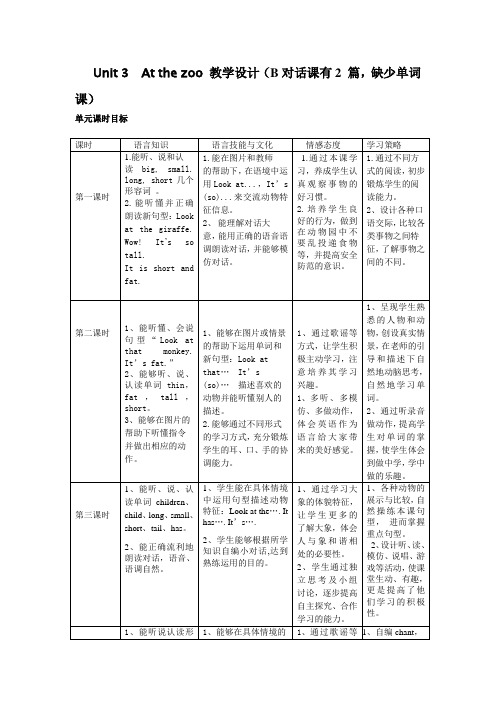
T:It’sshort.
Sn: 矮/瘦......。
T:Yes, you’reall right.It’sshort.It’sthin, too.
(不能否定说“瘦”的同学,但这不是本节课的重点可以一点而过。)T:It’s short↘, short↗,short↘.Ss: It’s short↘, short↗,short↘
第二课时
1、能听懂、会说句型“Look at that monkey. It’s fat.”
2、能够听、说、认读单词thin, fat,tall, short。
3、能够在图片的帮助下听懂指令并做出相应的动作。
1、能够在图片或情景的帮助下运用单词和新句型:Look at that…It’s (so)…描述喜欢的动物并能听懂别人的描述。
(1)T:What is the bear like? Watch the video again, and then answer.
A bear! It’sand.
A. tallB.shortC.fat
1、学习理解语言。
T:Look atthe bear.、It’sshort andfat.
老师并用强调的语气和肢体语言(同时两个胳膊在空中划一大圈来表示大熊胖的程度)
学生跟随教师说同样的句子做相同的动作进行从句子引出新词并加强练习为避免新词过于集中以熊图片引入新词fat从长颈鹿妈妈和长颈鹿宝宝的图片引入单词tallshort的教学及单词thin的渗透来降低学习的难度将反义词tallshort放在一起来学习直观教学对比明显一目了然学生易于掌握
Unit3At the zoo教学设计(B对话课有2篇,缺少单词课)
Unit3Atthezoo(单元解读)三年级英语下册(人教PEP版)
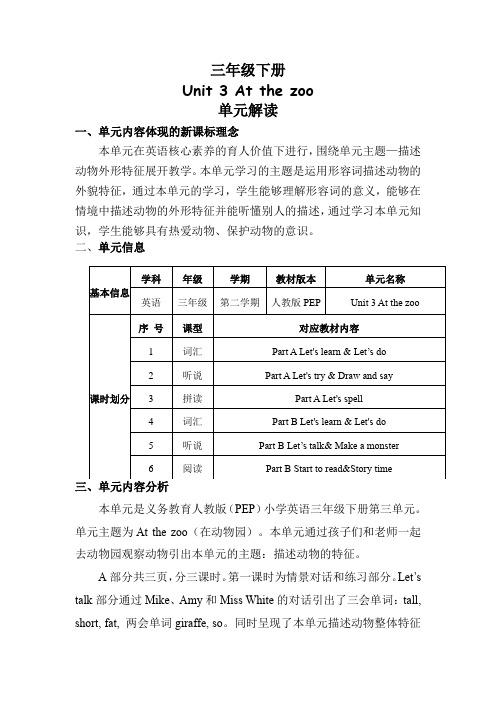
三年级下册Unit 3 At the zoo单元解读一、单元内容体现的新课标理念本单元在英语核心素养的育人价值下进行,围绕单元主题—描述动物外形特征展开教学。
本单元学习的主题是运用形容词描述动物的外貌特征,通过本单元的学习,学生能够理解形容词的意义,能够在情境中描述动物的外形特征并能听懂别人的描述,通过学习本单元知识,学生能够具有热爱动物、保护动物的意识。
二、单元信息本单元是义务教育人教版(PEP)小学英语三年级下册第三单元。
单元主题为At the zoo(在动物园)。
本单元通过孩子们和老师一起去动物园观察动物引出本单元的主题:描述动物的特征。
A部分共三页,分三课时。
第一课时为情景对话和练习部分。
Let’s talk部分通过Mike、Amy和Miss White的对话引出了三会单词:tall, short, fat, 两会单词giraffe, so。
同时呈现了本单元描述动物整体特征的句式:Look at that giraffe. It’s so tall. 在画一画,说一说的练习中,Chen Jie和John分别画了自己的动物,并使用重点句式来描述其特征。
学生通过这样的活动来操练在对话中学习到的重点句式。
第二课时为重点词汇和重点句型呈现,孩子们继续在动物园里游玩,发现了monkey和giraffe,从而呈现出三会词汇:tall, short, fat, thin,以及在Let’s talk中出现的描述动物的特征的句式:Look at that monkey. It’s fat. Let’s do是指令活动,学生需要根据指示做到变胖、变瘦、变高、变矮的动作,从而操练重点单词。
第三课时为语音学习,通过听一听、读一读、唱一唱、写一写活动,让学生理解并掌握字母i在单词里发的短音/ ɪ /。
B部分共四页,分三课时。
第一课时呈现情景对话和练习。
Miss White 带着孩子们观察大象,孩子们开始描述它具有的具体特征。
三年级英语下册第三单元

Unit 3 How do you come to school
※单元总目标:
本单元是以交通方式为话题,学习如何询问和描述到某个地方去所使用的交通工具。
功能结构以How do you come to schoolI come to school by bus.为主,结合学习----How do they/does he go to... They/ He goes to...by...句型,了解do在与不同人称I/he/she/they作主语的句子中的不同形式。
※单元具体目标:
在本单元的教学中,教师应通过设计安排多样的学习活动,借助各种
教学手段,引导学生达到以下知识目标和情感目标:
※知识目标:
一、能听、说、读写词汇:bus, train, ship, taxi, school, home.
二、能听懂、会说、会读、会用下列句型:
1、-----How do you come to school\go home
-----I come to school/go home...
2、----Do you come to school/go home...
-----Yes,I do./No,I don’t.
3、----How do they/does he go to...
----They/ He goes to...by...
※情感目标:
一、使学生养成良好的英语学习习惯,既要学会学习也要学会娱乐,做到
劳逸结合,提高学习效率。
二、创设情境,培养学生主动学习、创造性学习的能力。
秀延学区教学设计
秀延学区教学设计
秀延学区教学设计
秀延学区教学设计。
陕旅版英语三年级下册第三单元课件

How do they come to Beijing?
2. They go to the zoo by car.他们乘小汽车去动物园。
go to+地点 去某个地方
例:我乘飞机去西安。 I go to Xi’an by plane.
How do you go home, 你怎样回家, Go home, 回家, Go home in the afternoon? 在下午回家? By bus, 乘公共汽车, By bike, 骑自行车, On foot, 步行, I go home in the afternoon. 我在下午回家。
—How does your father go to zoo? —她骑自行车去动物园。 —She goes to zoo by bike.
Listen and do
Go on foot. 步行去。
Ride a bike. 骑自行车。
Drive a car. 开小汽车。
Take a bus. 乘公共汽车。
How do you go to school?
I go to school by bus.
Let’s sing
How Do You Come to School?
点击画面 播放视频
How do you come to school, 你怎样来学校, Come to school, 来学校, Come to school in the morning? 在早晨来学校? By bus, 乘公共汽车, By bike, 骑自行车, On foot, 步行, I come to school in the morning. 我在早晨来学校。
PEP版小学三年级英语下册第三单元教学反思.doc
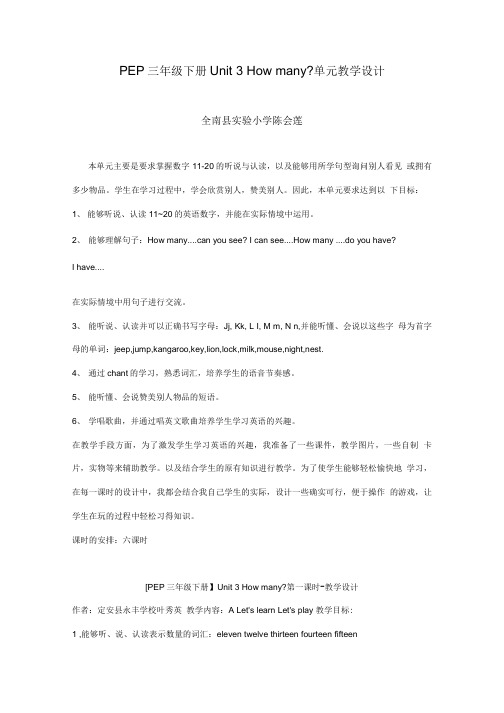
PEP三年级下册Unit 3 How many?单元教学设计全南县实验小学陈会莲本单元主要是要求掌握数字11-20的听说与认读,以及能够用所学句型询问别人看见或拥有多少物品。
学生在学习过程中,学会欣赏别人,赞美别人。
因此,本单元要求达到以下目标:1、能够听说、认读11~20的英语数字,并能在实际情境中运用。
2、能够理解句子:How many....can you see? I can see....How many ....do you have?I have....在实际情境中用句子进行交流。
3、能听说、认读并可以正确书写字母:Jj, Kk, L I, M m, N n,并能听懂、会说以这些字母为首字母的单词:jeep,jump,kangaroo,key,lion,lock,milk,mouse,night,nest.4、通过chant的学习,熟悉词汇,培养学生的语音节奏感。
5、能听懂、会说赞美别人物品的短语。
6、学唱歌曲,并通过唱英文歌曲培养学生学习英语的兴趣。
在教学手段方面,为了激发学生学习英语的兴趣,我准备了一些课件,教学图片,一些自制卡片,实物等来辅助教学。
以及结合学生的原有知识进行教学。
为了使学生能够轻松愉快地学习,在每一课时的设计中,我都会结合我自己学生的实际,设计一些确实可行,便于操作的游戏,让学生在玩的过程中轻松习得知识。
课时的安排:六课时[PEP三年级下册】Unit 3 How many?第一课时-教学设计作者:定安县永丰学校叶秀英教学内容:A Let's learn Let's play 教学目标:1 ,能够听、说、认读表示数量的词汇:eleven twelve thirteen fourteen fifteen2、能够在生活中很好地运用这些数词。
3、通过游戏活动,感受学习的乐趣,懂得与别人合作。
教学重点:掌握三会单词:eleven twelve thirteen fourteen fifteen教学难点:twelve的发音。
小学英语-人教版-三年级下-第三单元-讲练测

【重点解析】 此句型用于描述某种动物的外形特征。要加强语 气时,可在形容词前加so。
【生活实例】 儿童节那天,Mike和Marry到动物园玩,他们看到 了许多动物: Mike: Look at the panda. It’s so fat! 迈克:看这只熊猫。它好胖啊! Marry: How lovely! 玛丽:多可爱啊!
二、考试常备短语
1 look at... 看…… 2 small eyes 小眼睛 3 long nose 长鼻子 4 big ears 大耳朵
重点短语解析
look at... 看…… look at...是一个词组,表示看什么东西,后面一定要加看 的具体事物。
【例句】
Look at my cap. 看我的帽子。
C. tall
Hale Waihona Puke 二、看图,判断下列句子的描述是否正确,正确的打“√”,错误的打“×”。
( )The cat has a long tail.
( )The rabbit has long ears.
( )The bear has a big body.
( )The dog has big eyes.
( )The giraffe is tall.
小学三年级英语下册第三单元测试题
一、选出每组中不同类的单词。
( )1. A. long
B. short
C. boy
( )2. A. fat
B. big
C. duck
( )3. A. thin
B. dog
C. bear
( )4. A. small B. brown
C. red
( )5. A. sister B. brother
Unit3Animals课文原文与翻译(素材)鲁科版(五四学制)英语三年级下册
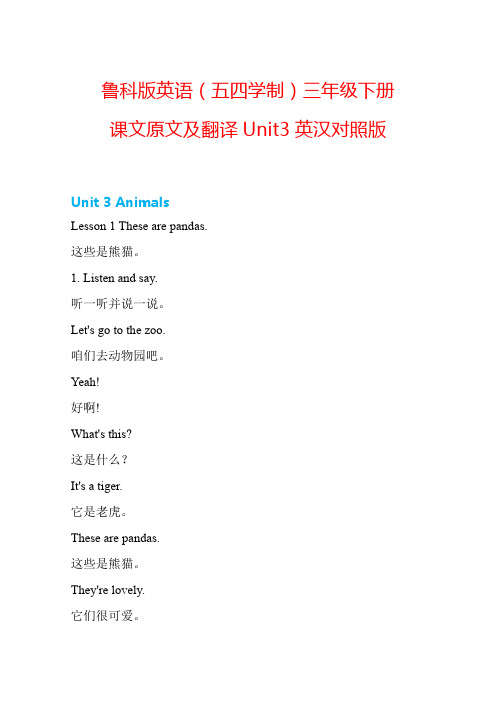
鲁科版英语(五四学制)三年级下册课文原文及翻译Unit3英汉对照版Unit 3 AnimalsLesson 1 These are pandas.这些是熊猫。
1. Listen and say.听一听并说一说。
Let's go to the zoo.咱们去动物园吧。
Yeah!好啊!What's this?这是什么?It's a tiger.它是老虎。
These are pandas.这些是熊猫。
They're lovely.它们很可爱。
Those are elephants.那些是大象。
So big!好大啊!2. Let's talk.对话。
Look! These are elephants.看!这些是大象。
So big!真大!Those are tiggers.这些是老虎。
3. Let's copy.抄写。
Oo Oo Pp Pp Qq QqLesson 2 What are these?第二课这些是什么?1. Listen and say.听一听并说一说。
What are these?这些是什么?They're bears.它们是熊。
What are these?这些是什么?They're rabbits.它们是兔子。
What are those?那些是什么?They're monkeys.它们是猴子。
Let's go and see the monkeys.咱们去看猴子吧。
OK.好的。
2. Let's talk.对话。
What are these?这些是什么?They're rabbits.它们是兔子。
3. Let's sing.唱一唱。
Let's all go to the zoo tomorrow.咱们明天都去动物园。
Let's all go to the zoo tomorrow, zoo tomorrow, zoo tomorrow.咱们明天都去动物园,去动物园,去动物园。
新版PEP三年级英语下册第三单元教案
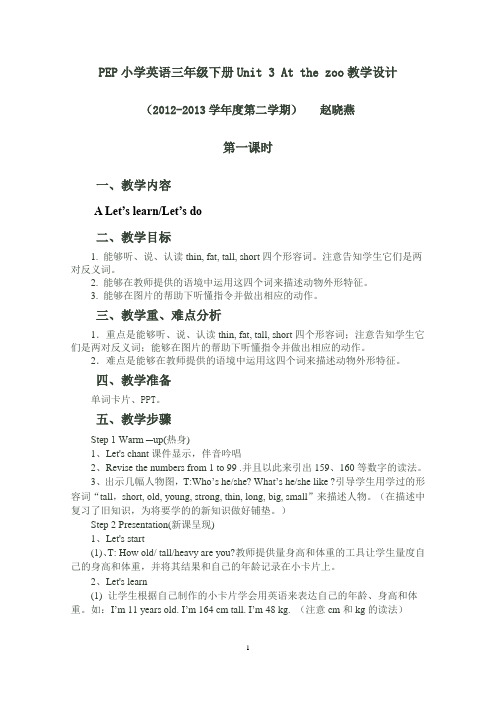
PEP小学英语三年级下册Unit 3 At the zoo教学设计(2012-2013学年度第二学期)赵晓燕第一课时一、教学内容A Let’s learn/Let’s do二、教学目标1. 能够听、说、认读thin, fat, tall, short四个形容词。
注意告知学生它们是两对反义词。
2. 能够在教师提供的语境中运用这四个词来描述动物外形特征。
3. 能够在图片的帮助下听懂指令并做出相应的动作。
三、教学重、难点分析1.重点是能够听、说、认读thin, fat, tall, short四个形容词;注意告知学生它们是两对反义词;能够在图片的帮助下听懂指令并做出相应的动作。
2.难点是能够在教师提供的语境中运用这四个词来描述动物外形特征。
四、教学准备单词卡片、PPT。
五、教学步骤Step 1 Warm ─up(热身)1、Let's chant课件显示,伴音吟唱2、Revise the numbers from 1 to 99 .并且以此来引出159、160等数字的读法。
3、出示几幅人物图,T:Who’s he/she? What’s he/she like ?引导学生用学过的形容词“tall,short, old, young, strong, thin, long, big, small”来描述人物。
(在描述中复习了旧知识,为将要学的的新知识做好铺垫。
)Step 2 Presentation(新课呈现)1、Let's start(1)、T: How old/ tall/heavy are you?教师提供量身高和体重的工具让学生量度自己的身高和体重,并将其结果和自己的年龄记录在小卡片上。
2、Let's learn(1) 让学生根据自己制作的小卡片学会用英语来表达自己的年龄、身高和体重。
如:I’m 11 years old. I’m 164 cm tall. I’m 48 kg. (注意cm和kg的读法)(2)Pair work:用句子How old/ tall/heavy are you? 来询问同桌的年龄、身高、重量并进行回答。
三年级下册英语剑桥 第3单元

Unit3 Clothes
单词 toy
音标
词性 词义 解析
名词 玩具 例句:Tony has got many toys。
wear 穿着的状态,可用于衣服鞋帽眼镜首饰 He is wearing a pair of glasses。他戴着一副眼镜
put on 强调穿戴动作
This is your hat.Put it on.这是你的帽子,戴上他 它吧
dress 给...穿衣,宾语只能是人,不能是衣服 Mum dresses Danny quickly。妈妈迅速给丹尼穿好衣 服
What's his name? 他叫什么名字?
Number 2:It's a girl. 这是一个女孩。She's wearing a blue sweater and
ue sweater and white jeans. 一件蓝色的毛衣和白色的牛仔裤。
3、John is wearing green socks. W
John穿着绿色的袜子。
4、Sue is wearing red shoes. R
Sue穿着红色的鞋子。
5、Andy is wearing a blue and yellow cap. W
Andy戴着蓝黄相间的帽子。
6、Jane is wearing a pink sweater.
单词巧记 joy-toy
dress
dres
名词 连衣 例句:This is Helen‘s dress。这是海 分析:dr—“大人”的拼音首字母;e—
人教版三年级下册英语·Unit3 PPT
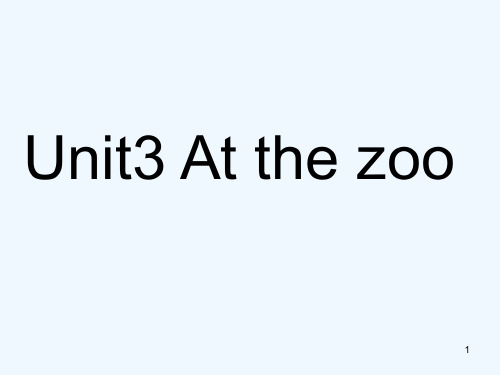
• B( )4.老师带领同学们做游戏,下口令:让你
自己变高,应说:
A. Make yourself long. B.Make yourself tall.
53
情景选择
(B)1.小白兔自我介绍:我有红红的眼睛,长长
50
翻译
(C)4. 哇!它有一个小脑袋。 A.Wow! It has a big head. B.Wow!It has a small nose. C.Wow!It has a small head. (B)5.大象又大又肥。 A.The pig is big and fat. B.The elephant is big and fat. C.The elephant is tall and thin.
catlook大家有疑问的可以询问和交流大家有疑问的可以询问和交流可以互相讨论下但要小声点可以互相讨论下但要小声点10选汉语意思3frienda
Unit3 At the zoo
1
animals
2
Don’t feed the animals!
禁止给动物喂食!
3
deer short
4
giraffe
(B)说1:.森林选美大赛上,动物们都各说所长,长颈鹿应
A. I have small eyes! B.I have a long neck.
(A)2.小松鼠骄傲地对小白兔说:“我有长长的大尾
巴!”,小白兔应说: A. I have red eyes. B.I have a long tail,too.
They are_b_ig_. 42
三年级下册英语第三单元课文教案

三年级下册英语第三单元课文教案三年级下册英语第三单元课文教案一、说教材本课内容是人教版三年级下册第三单元《At the Z》,第二课时包括Let’s learn和Let’s d Let’s spell三部分。
主要教学四个形容词thin, fat, tall, shrt 。
新英语课程标准指出,基础教育阶段英语课程的总体目标是培养学生的综合语言运用能力。
根据一级目标要求,对教学内容的分析、本教材的特点及学生现有的基础。
教学目标:1、能听、说、认读thin, fat, tall, shrt ,并理解词义。
2、听懂含有形容词的几个指令,并按指令做动作。
3、在活动中习得语言,激发学生学习英语的兴趣。
教育学生爱护动物,懂得动物是世界不可缺少的一部分。
教学重、难点本课时教学重点是能听、说、认读几个形容词thin, fat, tall, shrt 。
听懂含有形容词的几个指令,并按指令做动作。
教学难点是单词thin的发音。
二、说学法我通过与扮演司机跟导游来吸引学生们的注意力,既复习了新知,活跃了课堂气氛、也拉近了师生之间的距离。
学习完本节的单词后,又让学生们用恰当的词语来形容上出现的动物,为了进一步巩固今天的学习要点。
而且做到自己造句子。
其中,有几次都复习了旧知,把学过的动物单词再次的扩展,让学生们会描述其特征。
三、说教法在本课时的教学设计中,我从学生的兴趣和认知水平出发,利用有趣的图片吸引学生的注意力。
再用旅观光团通过唱歌曲、走迷宫活动,让学生在愉快中学习,激发学生学习英语的兴趣,帮助他们建立学习的成就感和自信心。
通过用旧知识引入本课新知识的`方法,让学生主动参与到学习中去。
在猜一猜、的活动过程中,尝试做课堂的主人。
引导学生观察、思考,使他们不仅掌握本节课的内容,而且在学习过程中,不断产生新经验、新认识,并由此发展学生各方面的能力,形成积极的人生态度,促进个性成长。
根据学生的个性特点,我主要采用图片、多媒体以及教师丰富的体态语言等教学手段进行教学,它们能活化教材,辅助教师对教学内容进行有序讲解,在讲解的过程中,能充分利用有的教学时间,改善信息的传递方式,增强信息的传递能力,使外语学习变得生动活泼,加深学生对教学内容的理解。
人教PEP版英语三年级下册Unit 3 At the zoo 单元复习讲义(讲义+练习)
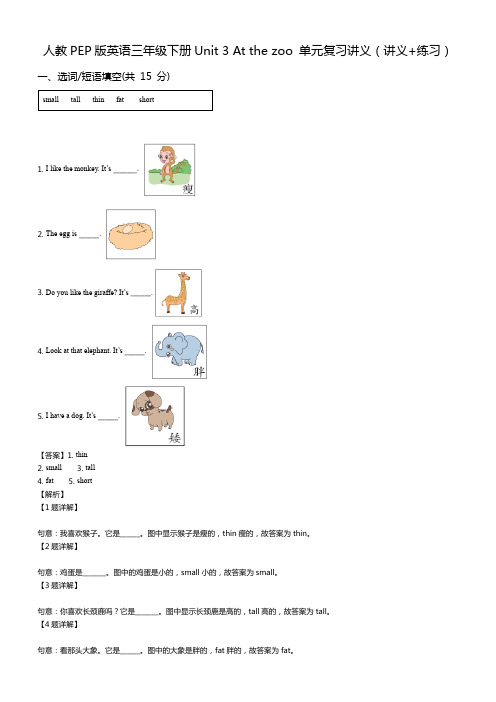
人教PEP版英语三年级下册Unit 3 At the zoo 单元复习讲义(讲义+练习)一、选词/短语填空(共15 分)1. I like the monkey. It’s _______.2. The egg is ______.3. Do you like the giraffe? It’s ______.4. Look at that elephant. It’s ______.5. I have a dog. It’s ______.【答案】1. thin2. small3. tall4. fat5. short【解析】【1题详解】句意:我喜欢猴子。
它是______。
图中显示猴子是瘦的,thin瘦的,故答案为thin。
【2题详解】句意:鸡蛋是_______。
图中的鸡蛋是小的,small小的,故答案为small。
【3题详解】句意:你喜欢长颈鹿吗?它是_______。
图中显示长颈鹿是高的,tall高的,故答案为tall。
【4题详解】句意:看那头大象。
它是______。
图中的大象是胖的,fat胖的,故答案为fat。
【5题详解】句意:我有一只狗。
它是______。
图中的狗是矮的,short矮的,故答案为short。
二、语音选择题(共15 分)选出每组划线字母发音不同的一项。
6. A.six B.like C.gift7. A.big B.nice C.it8. A.pig k C.nine9. A.fish B.kite C.five10. A.rice B.thin C.is【答案】6. B 7. B 8. C 9. A 10. A【解析】【6题详解】A和C中的i都发/ɪ/,B中的i发/aɪ/,故选B。
【7题详解】A和C中的i都发/ɪ/,B中的i发/aɪ/,故选B。
【8题详解】A和B中的i发/ɪ/,C中的i发/aɪ/,故选C。
【9题详解】A中i发/ɪ/,B和C中的i发/aɪ/,故选A。
【10题详解】A中i发/aɪ/,B和C中i发/ɪ/,故选A。
Unit3AtthezooBLet’slearnstarttoread(教学设计)人教PEP版英语三

人教版《英语》(三年级起点)三年级下册Unit 3 At the zooB Let’s learn & start to read教学设计一、课例背景针对课时减少而进行单元整体教学设计,围绕单元主题,充分挖掘育人价值,确立单元育人目标和教学主线,整合教学内容,规划系列教学活动,推进信息技术与英语教学的深度融合,促进学生能力的发展和素养的提升。
二、教学分析(一)教学内容分析基于2022版《英语课程标准》指出教师需深入解读和分析单元内各语篇及相关教学资源,并结合学生的认知逻辑和生活经验,对单元内容进行必要的整合或重组,建立单元内各语篇内容之间及语篇育人功能之间的联系,形成具有整合性、关联性、发展性的单元育人蓝图。
本单元教学内容属于人与自然主题范畴,单元整体教学设计围绕话题“Animals”进行,分别设计了五个环环相扣的子主题:A big big day、Animals at the zoo、Go to the zoo、Animal riddles、Wonderful and funny animals ,分五个课时整合完成单元教学内容,体现让学生从认知与写作逻辑“复习拓展动物词汇、描述动物整体轮廓、细节描述动物体态特征”及生活实际经验“去动物园前(一、二课时:大情景铺垫与词汇储备)——在动物园(三、四、五课时:初看动物——细观动物——情感升华)”对教材内容的科学整合。
逐步建构和生成围绕单元主题的深层认知、态度和价值判断,促进其核心素养综合表现的达成。
本课教学内容属于人教版《英语》教材三年级下册第三单元该教学内容为PEP英语三年级下册Unit 3 At the zoo B Let’s learn & start to read,为本单元整体教学的第四课时以John、Chen Jie为人物主线,以大情景参观动物园整合教材内容,通过观察鸵鸟的身体部位特征学习描述性词汇“big,small, short,long”、身体部位tail, 及句型“It has... ”阅读Start to read 动物谜语,猜猜所描述是哪种动物。
人教版三年级英语下册第三单元教案

Unit 3 At the zoo 单元目标[教材分析]本单元学习的话题是动物。
通过教师和孩子们参观动物园的情境呈现了本单元的核心句型: Look at that ... It’s so tall ... It has a ...。
教师可参考上册Unit4 We love animals.引入本单元的Look at that + animals. 句型来描述动物的特征,激活学生已有的相关知识和生活经历,帮助学生学习本单元的主要学习内容。
教师应在热身环节巩固复习学过的词汇duck, pig, cat,bear,dog ... 等,在此基础上学习句型Look at that giraffe.并展开对话。
本单元出现的新知识点:形容词的反义词:如tall→short, fat→thin; short→long; small →big,在情境中帮助学生理解。
Let’s spell将学习元音字母i的发音及其四个发音例词:pig, big, six, milk,学习元音字母i在闭音节里的发音规律和几个含有元音字母i的闭音节单词的书写。
在教学中应注意培养学生书写和记单词的良好习惯。
逐步培养孩子拼读,拼写单词的能力。
Story time 用生动有趣的小故事,再现本单元的主要单词和词汇。
教师应围绕animals这一-主题设计,让学生在轻松愉快的环境中听读故事,感受语言,理解语言。
[目标预设]1.借助图片和录音,能听懂、会说句型: It’s so tall/short ... It has ...2.能够正确、熟练地朗读对话,做到语音、语调自然地道。
3.能够听、说、认、读单词: tall,short, fat, thin,big, small, long。
4.能够听懂、会说单词: giraffe, so ,children, tail。
.5.知道元音字母i在单词中的短音发音/I/。
6. Story time的内容,学生能理解并选择自己喜欢的部分朗读。
三年级英语下册教案Unit3Whatisinthebox辽师大版(三起)

三年级英语下册教案Unit3 What is in the box 辽师大版(三起)教学内容:本节课是辽师大版(三起)三年级英语下册的第三单元,主题为"What is in the box?"。
教学内容主要包括对 box,toy,apple,orange,egg 等单词的学习,以及 What is in the box? There is a 句型的掌握。
通过本节课的学习,学生能够询问并回答盒子里有什么。
教学目标:1. 语言知识:学生能够听懂、会说、会读本节课的重点单词和句型。
2. 语言技能:学生能够在真实情境中运用所学单词和句型询问并回答盒子里有什么。
3. 情感态度:培养学生对英语学习的兴趣,激发学生的好奇心和探索欲望。
4. 学习策略:通过图片、实物等教学手段,帮助学生理解和记忆单词和句型。
教学难点:1. 学生对句型 What is in the box? There is a 的理解和运用。
2. 单词 toy,apple,orange,egg 的发音和书写。
教具学具准备:1. 教具:多媒体课件、图片、盒子和实物(玩具、苹果、橙子、鸡蛋等)。
2. 学具:学生用书、练习本、彩笔。
教学过程:1. 导入:通过展示一个神秘的盒子,引发学生的好奇心,导入本节课的主题。
2. 新课呈现:利用多媒体课件和图片,展示本节课的重点单词和句型,引导学生跟读并模仿。
3. 操练:通过小组活动、角色扮演等形式,让学生在真实情境中运用所学单词和句型。
4. 巩固:设计一些趣味性的练习,帮助学生巩固所学知识。
6. 作业布置:布置相关的作业,让学生课后进行复习和巩固。
板书设计:1. 在黑板上画出本节课的重点单词和句型,配以图片和简笔画,增强视觉效果。
2. 用彩笔标注出单词和句型的重点部分,便于学生记忆。
作业设计:1. 听力作业:听录音,跟读并模仿本节课的重点单词和句型。
2. 书面作业:抄写本节课的重点单词和句型,加强对单词的记忆。
三年级下册英语单词第3单元

三年级下册英语单词第3单元English: In the third unit of the third grade English textbook, students will learn a variety of new vocabulary words related to different topics such as feelings, occupations, and activities. Some of the new words students will learn include happy, sad, doctor, teacher, swim, dance, and play. These words will be introduced through fun and interactive activities to help students remember and understand them more easily. By using these new words in sentences and conversations, students will be able to practice their English language skills and improve their overall proficiency. Additionally, students will have the opportunity to participate in group activities and games that will further reinforce their understanding of the new vocabulary words. Overall, this unit aims to expand students' English vocabulary and enhance their language learning experience in an engaging and interactive way.中文翻译: 在三年级英语教材的第三单元中,学生将学习与情感、职业和活动等不同主题相关的各种新词汇。
Unit3StoryTime(课件)人教新起点版英语三年级下册

小学英语
Activities of My Day
get up
have breakfast have online classes
At 7 o’clock, I’m going to… At
run study , I’m going to…
小学英语
Activities of My Day
At
, I’m going to… At
小学英语
listen and read.
1.How many students are there in the story?
2.Why is the boy so tired?
小学英语
Read again.
What is he going to do?
暂停播放5 分钟,读故 事。
小学英语
Read and answer.
小学英语
Unit 3 After SchoolActivities Story Time
小学英语
Jeeby
Jeeby is going to sisnign.g
Pod
Pod is going to ssleleeepp.
Tappy
Tappy is going to ddaannccee.
They are going to
小学英语
1. Who are they? 2.What are they wearing? 3.What are they going to do after school?
小学英语
What are you going to do?
I’m going to play ping-pong. I’m going to get my bat.
三年级英语人教版下册第三单元课文

三年级英语人教版下册第三单元课文The third unit of the third grade English textbook of People's Education Press is about "My weekend". In this unit, students will learn how to talk about their weekend activities, express their likes and dislikes, and use simple present tense to describe daily routines. The main language points include the words and phrases related to weekend activities, the structure of "What do you do on weekends?", and the use of adverbs of frequency.To start with, the unit introduces some common weekend activities such as playing football, watching TV, reading books, and so on. Then, it provides a dialogue between two students, in which they talk about their weekend activities and express their likes and dislikes. After that, the unit focuses on the adverbs of frequency, teaching students how to use words like "always", "often", "sometimes", "rarely", and "never" to describe how often they do certain activities.In the following part, there are some exercises for students to practice the language points they have learned. For example, they need to fill in the blanks with the adverbs of frequency, complete the sentences with the correct weekend activities, and write about their own weekend routines. These exercises are designed to help students consolidate what they have learned and apply it in real-life situations.After that, there is a reading passage about a girl named Amy and her weekend activities. Students can learn from the passage how to describe their own weekend routines in a more detailed and organized way. The passage also provides some good examples of using the simple present tense to talk about habitual actions.To sum up, this unit is very practical and useful for students to learn how to talk about their weekend activities in English. By mastering the language points and practicing the exercises, students can not only improve their English speaking and writing skills, but also develop the habit of expressing themselves in English. It is important for students to be able to communicate in English about their daily life, and this unit provides them with a good opportunity to do so. I believe that with the help of this unit, studentswill make great progress in their English learning and become more confident in using English to communicate with others.。
- 1、下载文档前请自行甄别文档内容的完整性,平台不提供额外的编辑、内容补充、找答案等附加服务。
- 2、"仅部分预览"的文档,不可在线预览部分如存在完整性等问题,可反馈申请退款(可完整预览的文档不适用该条件!)。
- 3、如文档侵犯您的权益,请联系客服反馈,我们会尽快为您处理(人工客服工作时间:9:00-18:30)。
英语听写纸(第三单元)
【词汇闯关】
汤米饭喜欢一些请
蔬菜好的最喜欢的什么哪里
读鸡蛋学校面包牛奶
【句子测试】
让我们吃吧!这个果汁真好喝!
我非常饿。
这是什么?
你想要一些饺子吗? 好的,请给我来一些。
你想要一些面条吗?好的,请给我来一些。
你想要一些米饭吗?不用了,谢谢你了。
我喜欢水果。
我不喜欢蔬菜。
我喜欢饺子。
饺子很好吃。
我最喜欢的食物是饺子。
你最喜欢的食物是什么?
早上好,妈妈!
下午好,爸爸!
在早上,我吃早餐。
然后我去学校。
我早餐喜欢吃面条。
我早餐喜欢喝汤。
